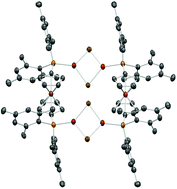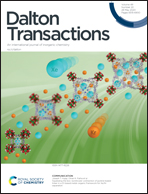Abstract
Two bulky mesityl substituted dppf-analogues Fe(C5H4PMes2)2 (Mes = 2,4,6-Me3C6H2, 1) and Fe(C5H4PMes2)(C5H4PPh2) (Mes = 2,4,6-Me3C6H2, Ph = C6H5, 3) have been prepared and their properties as donor ligands have been explored using heteronuclear NMR spectroscopy and in particular via1JP–Se coupling, cyclic voltammetry and DFT calculations. Based on the results obtained, a series of mono- and dinuclear Cu(I) complexes have been prepared with these new diphosphane ligands using Br−, I−, and BF4− as counter anions. For the very bulky ligand 1 rare and unprecedented double bridging complexation modes have been observed containing two non-planar Cu2Br2 units, while for the other dinuclear complexes planar Cu2Br2 units have been found. The Cu(I) complexes of 1 and 3 were then used as catalysts for CO2-fixation reaction with terminal alkynes, and complexes with ligand 3 were found to be more efficient than those with 1. DFT calculations performed on compounds 1, 3 and their Cu(I) complexes were able to verify the trend of these catalytic reactions.



 Please wait while we load your content...
Please wait while we load your content...